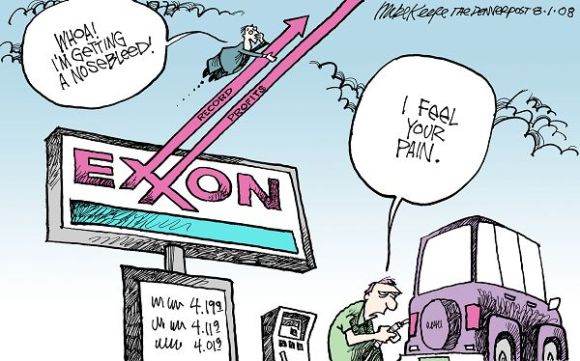Exxon,by virtue of its operational sector, is usually a lightning rod for controversy. Whether it is due to the fact that its products contribute to global warming, or because everyone who works for the company is perceived to be like the individual in the cartoon below.
The result is that the company seemingly is always under attack. Perennially however, Exxon seems to do one thing right: forecasting energy trends. And by all accounts, the company sees North America as becoming a net energy exporter by 2025.
Exxon’s glowing predictions for the continent stem from North America becoming less reliant on coal-based power plants, and instead, depending more on energy efficient natural-gas-fired plants. Overall, the oil giant sees coal use dropping 33% from 2010 to 2025, a substantially larger increase than its previous 23% estimate.
In addition, because North America, and particularly the United States, contains an abundance of natural gas reserves, and is working to perfect the hydraulic fracturing and horizontal drilling techniques needed to unlock them, the continent has become energy rich in the clean burning fuel of the future. As a result, North America will become the go-to source to feed the growing energy demands of industrialized nations. In fact, Exxon’s report states that, “Global energy demand will increase 35% from 2010 to 2040, with most of the increased demand coming from developing nations like India and China.” By setting the initiative of becoming a global superpower in clean energy technologies, North America has positioned itself well to become less reliant on foreign oil, while at the same positioning itself as a provider of clean energy for other nations.
Remarkably enough, “By 2040 developed nations like the US and Canada are expected to generate 80% more economic output than in 2010 but use the same amount of energy.” This speaks to North America’s attempt to be on the cutting edge of this breakthrough technology and to the unmistakable way in which innovation can change a nation from a net importer to net exporter. (I’m looking at you United States) As clean energy becomes more and more of a priority with each passing day, it is refreshing to see how the green movement has changed political decision making. Let’s continue to make sustainability a priority both at home and abroad so that we can all live green, and be green.




